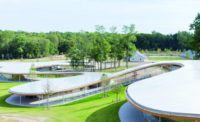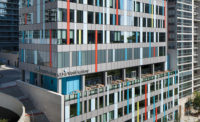London
Set back from the road, Zaha Hadid's Evelyn Grace Academy in South London zigzags across its small site with jagged angles of bare concrete, glass, and silver-spray-painted aluminum. The newly founded secondary school—for pupils ranging in age from 11 to 19—is state-funded, but owned and operated by ARK (Absolute Return for Kids), an educational charity organization that contributes additional financial support.
“ARK wanted a grown-up building,” project director Lars Teichmann says of the brief. “Neutral and functional rather than playful and childish.” The energetic, striking result recently won Hadid the Stirling Prize for the second year in a row (last year she won for the MAXXI museum in Rome), beating stiff competition, including David Chipperfield's Folkwang Museum in Essen, Germany, and Hopkins' Velodrome for next summer's London Olympics.
The 3½-acre site, jammed between a maintenance depot for garbage trucks and a building that stores data from the city's surveillance cameras, is one-quarter the size of an average secondary school site in London. The institution specializes in math and sports, and Hadid's design cleverly maximizes the grounds. The building meanders between a synthetic-turf soccer field and two basketball courts, and a bright red 100-meter running track cuts under and through the building, bisecting the site and linking its two entrances. Pupils literally run to school.
This disadvantaged area of Brixton is, says headmaster Peter Walker, “the highest violent-crime ward in Western Europe.” Gang culture is a serious problem in the nearby housing projects from where the school's 1,200 pupils are drawn. 80 percent are African-Caribbean; 55 percent qualify for free school meals (three times the national average); and 60 percent are on the “special needs register,” with emotional and behavioral difficulties. Walker thinks that secondary schools, especially in the inner city, are too large and, following an American model, has broken Evelyn Grace Academy into four smaller, more manageable units that he refers to as “schools within a school.” (Jay Altman, who founded several charter schools in New Orleans, served as educational advisor.)
The school is divided into two middle and two upper academies, each with a head teacher and some dedicated staff, learning, and play spaces. These are easily visualized within the sculptural articulations of the facade. “We tried to express those four elements of the school in the massing of the building,” Teichmann explains. A middle and upper school are stacked atop one another in the wings of the building, where they jigsaw dynamically between floors. Each school also has its own entrance and staircase, as well as a sheltered terrace where pupils can congregate during breaks, so that older and younger students can choose whether or not to mix in the larger playground. Students share communal spaces in the middle of the structure, two large multi-purpose halls with floor-to-ceiling glazing where they meet for assemblies, meals, and indoor games.
Hadid didn't want the building to loom over the area, as some of the surrounding 1970s-era housing does. Instead, says Teichmann, the school aims to “stitch up” the discordant urban fabric in which it is set. To reduce the building's mass, it is built on a podium, partially concealing shared, daylight-filled facilities for sports, music, and art, as well as a library and reception area. These concrete buttresses serve to ramp up the building, making it look as if it only has three floors, and to insulate the school from the street. “We tried to soften the blow of the volume by hiding one floor,” Teichmann says, “making it look more slender and less high.” Walker concurs: “The architects created something that is both startling yet somehow settles into the neighborhood. Unobtrusive is the wrong word, but it doesn't dominate.”
In contrast to the arresting exterior, the interior is fairly basic, a victim of last-minute cost-cutting. There is the traditional arrangement of spines of wide corridors with classrooms branching off them. “These always lead to a room that is glazed or lit, so there are always views offered,” Teichmann says, “Bullying happens in dark corners and staircases, so we tried to avoid those.” Lockers are built into walls that sit in the corridors like furniture pieces, with clerestory windows above, so that the ceilings of the corridors continue seamlessly into the classrooms. The doors are full-height, and a vertical strip of glass alongside them allows for what Teichmann refers to as “passive supervision.”
ARK, a philanthropic enterprise founded by Swiss financier Arpad Busson, contributed 90 percent of the school's $55.5 million construction costs. The building is one of the last to be completed under the Labour Party's Building Schools for the Future program, which was scrapped by the incoming coalition government. Michael Gove, the U.K.'s new Conservative Education Secretary, is unsympathetic to such an architecturally ambitious enterprise. “We won't be getting Richard Rogers to design your school,” he told a recent education conference, “We won't be getting any 'award-winning architects' to design it, because no one … is here to make architects richer.”
Rogers protested in an open letter to the press, pointing out that only the previous day, Gove had praised Mossbourne Academy, which used to be one of Hackney's failing schools but had been transformed, partly thanks to a new building, that happened to be designed by Rogers. Many critics thought that Hadid's winning of the Stirling Prize for the second year running was the bruised architectural establishment's rejoinder to Gove, and there was some grumbling about her victory in the local architectural press. Evelyn Grace Academy is the only school ever to win the prize.
Hadid and Rogers have built just one school each in the U.K. “While we had a lot to absorb working on a publicly funded, educational project,” reflects Teichmann, “we in turn had the advantage of coming to the project with a fresh look, which meant we were able to challenge the standard reactions to school design.” Hadid brings to the project some of the trademark flash of her BMW factory in Leipzig, which also has vaults over its entrance, or her soon-to-be-completed Pierres Vives building in Marseille, which has a recessed glass and concrete facade that drops and swoops between floors (Hadid compares the form to a “tree of knowledge”).
“This building makes a statement about our education,” says Walker of Evelyn Grace. “What impact will coming to a school like this have subliminally on these kids?”
Total construction cost: $56 million
Location: 255 Shakespeare Road – SE24 0QN, London, UK
Size: 115,658 square feet
Completion date: October 2010
People
Owner:
Architect:
Personnel in architect's firm who should receive special credit:
Project director: Lars Teichmann, (registered architect) Project team: Bidisha Sinha, Henning Hansen, Lisamarie Villegas Ambia, Enrico Kleinke, Judith Wahle, Christine Chow, Guy Taylor, Patrick Bedarf, Sang Hilliges, Hoda Nobakhti Interior designer: Zaha Hadid Architects Engineer(s): Arup
Consultant(s): General contractor: MACE Plus Photographer(s): Luke Hayes; Hufton + Crow, Renderer(s): Courtesy of Zaha Hadid Architects
CAD system, project management, or other software used: |
Products
Structural system
Exterior cladding Metal/glass curtain wall: Schuco FW60+ aluminum curtain wall system with pressurized fixed glass system and metal panel rainscreen / over-cladding bands Rainscreen (terra cotta, composite, etc.): refer metal panels Wood: Beech wood sprung floors and Beech wood benches Moisture barrier: Reinforced membranes. Liquid-applied membranes only used as part of Roof coatings Curtain wall: refer Metal/ Glass curtain wall Other cladding unique to this project: Fair-Face concrete ‘TwinWalls’ to ground floor areas.
Roofing Elastomeric: refer roof build up Tile/shingles: Paving Slabs – Marshalls mono-standard Other: Local Gravel in two colors as full ballast to sports hall roof.
Windows
Glazing Skylights: Insulating DG unit, outer pane toughened Pilkington ‘Activ Blue’ inner pane low-e coating Insulated-panel or plastic glazing: Glazing type same as rest of curtain glazing with ceramic fritting to face 4
Doors Metal doors: Schuco aluminum frame doors Wood doors: Melamine veneered wood chip doors with beech lipping Sliding doors: see Entrances Fire-control doors, security grilles: n/a, entrance doors also means of escape, Mag locks to fail safe open upon alarm
Hardware Closers: TS4000 Overhead Door Closers
Interior finishes Demountable partitions: Dorma moveable, double-height partitions to common halls and serveries. Paints and stains: white vinyl matt emulsion to walls Wall coverings: Dry lining, British Gypsum Floor and wall tile (cite where used): white & lime ceramic tiles 100x100, used on wall linings of wet areas Resilient flooring: Resin floor to main Reception area Carpet: Interflor Special interior finishes unique to this project: Capadecor Metallocryl paint in Gold / Blue / Silver in circulation spaces
Furnishings Tables: moisture resistant board faced with trespa or melamine laminate with metal support frame work
Lighting Downlights: recessed down light c/w matt anodised reflector by Escapezone Exterior: 1000w metal Halide by Philips Dimming System or other lighting controls: refer Interior Ambient Lighting
Conveyance
Plumbing
Energy
Other unique products that contribute to sustainability:
Add any additional building components or special equipment that made a significant contribution to this project: Artificial grass pitch: Synthetic Turf Pitch ( tufted synthetic grass, partially filled with sand & rubber granules) Multi Use Game Area: Green Spray Painted Macadam (base course + wearing course) |

























Post a comment to this article
Report Abusive Comment